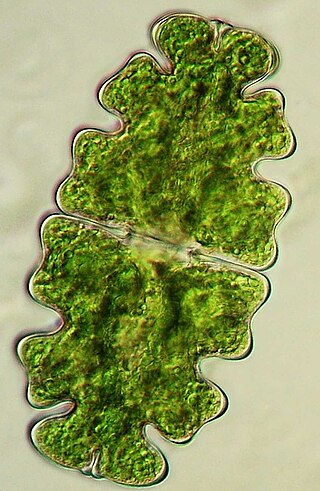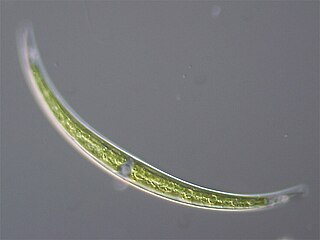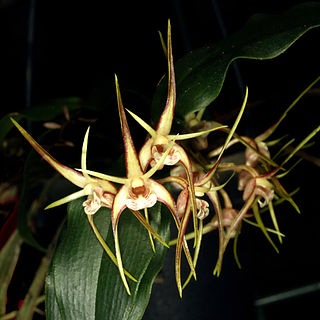
Desmidiales, commonly called the desmids, are an order in the Charophyta, a division of green algae in which the land plants (Embryophyta) emerged. Desmids consist of single-celled microscopic green algae. Because desmids are highly symmetrical, attractive, and come in a diversity of forms, they are popular subjects for microscopists, both amateur and professional.

Euastrum oblongum is a species of desmid, in the family Desmidiaceae.

Micrasterias is a unicellular green alga of the order Desmidiales. Its species vary in size reaching up to hundreds of microns.

Closterium is a genus of desmid, a group of charophyte green algae. It is placed in the family Closteriaceae. Species of Closterium are a common component of freshwater microalgae flora worldwide.

Cosmarium is a genus of freshwater organisms belonging to the Charophyta, a division of green algae from which the land plants (Embryophyta) emerged.

Desmidium is a genus of green algae, specifically of the Desmidiaceae.

Triploceras is a genus of desmid in the family Desmidiaceae.

Dendrobium tetragonum, commonly known as the tree spider orchid, is a variable species of epiphytic or lithophytic orchid endemic to eastern Australia. Tree spider orchids are unusual in having pendulous pseudobulbs that are thin and wiry near the base then expand into a fleshy, four-sided upper section before tapering at the tip. There are only a few thin but leathery leaves at the end of the pseudobulbs and up to five flowers on relatively short flowering stems. To allow for the variations in the species there are five subspecies and a variety, some with a unique common name.

Pediastrum duplex is a species of fresh water green algae in the genus Pediastrum. It is the type species of the genus Pediastrum.

Psilocybe aztecorum is a species of psilocybin mushroom in the family Hymenogastraceae. Known from Arizona, Colorado, central Mexico, India and Costa Rica, the fungus grows on decomposing woody debris and is found in mountainous areas at elevations of 2,000 to 4,000 m, typically in meadows or open, grassy conifer forests. The mushrooms have convex to bell-shaped caps 1.5–2 cm (0.6–0.8 in) in diameter, atop slender cylindrical stems that are up to 7.5 cm (3.0 in) long. The color of the caps changes with variations in hydration, ranging from dark chestnut brown to straw yellow or whitish when dry. The base of the stem is densely covered with conspicuous white rhizomorphs, a characteristic uncommon amongst Psilocybe species.

Amanita exitialis, also known as the Guangzhou destroying angel, is a mushroom of the large genus Amanita. It is distributed in eastern Asia, and probably also in India where it has been misidentified as A. verna. Deadly poisonous, it is a member of section Phalloideae and related to the death cap A. phalloides. The fruit bodies (mushrooms) are white, small to medium-sized with caps up to 7 cm (2.8 in) in diameter, a somewhat friable ring and a firm volva. Unlike most agaric mushrooms which typically have four-spored basidia, the basidia of A. exitialis are almost entirely two-spored. Eight people were fatally poisoned in China after consuming the mushroom in 2000, and another 20 have been fatally poisoned since that incident. Molecular analysis shows that the species has a close phylogenetic relationship with three other toxic white Amanitas: A. subjunquillea var. alba, A. virosa and A. bisporigera.

Lactarius alnicola, commonly known as the golden milkcap, is a species of fungus in the family Russulaceae. The fruit bodies produced by the fungus are characterized by a sticky, vanilla-colored cap up to 20 cm (7.9 in) wide with a mixture of yellow tones arranged in faint concentric bands. The stem is up to 5 cm (2.0 in) long and has yellow-brown spots. When it is cut or injured, the mushroom oozes a white latex, which has an intensely peppery taste. The acrid taste of the fruit bodies renders them unpalatable. The fungus is found in the western United States and Mexico, where it grows in mycorrhizal associations with various coniferous trees species, such as spruce, pine and fir, and deciduous species such as oak and alder. It has also been collected in India. Two varieties have been named: var. pitkinensis, known from Colorado, and var. pungens, from Michigan.

Codium fragile, known commonly as green sea fingers, dead man's fingers, felty fingers, forked felt-alga, stag seaweed, sponge seaweed, green sponge, green fleece, sea staghorn, and oyster thief, is a species of seaweed in the family Codiaceae. It originates in the Pacific Ocean near Japan and has become an invasive species on the coasts of the Northern Atlantic Ocean.

Pluteus americanus is a North American and Russian psychedelic mushroom that grows on hardwoods.
Parapionosyllis winnunga is a species belonging to the phylum Annelida, a group known as the segmented worms. Parapionosyllis winnunga is characterized by the shape of the blades of its compound chaetae, which have a long subdistal spine, in turn much longer than in other cogenerate species. Its species name is derived from the Aboriginal word winnunga, meaning "small".

Mariannaea elegans an anamorphic fungus. It is mainly found on rotting wood and soil. M. elegans is not pathogenic to humans, animals, or plants.

Cosmarium botrytis is a species of green algae in the family Desmidiaceae. It is a freshwater species with a worldwide distribution, and has been recorded from all continents.
Prescottiella is a genus of green algae in the family Desmidiaceae, containing the single species Prescottiella sudanensis. Originally classified as Micrasterias sudanensis in 1958, it was moved into its own genus by Carlos E. M. Bicudo in 1976, due to its asymmetric character. It is named after Gerald Webber Prescott, an American phycologist.

Xanthidium antilopaeum is a species of unicellular desmid in the family Desmidiaceae. It is a common, worldwide species found in acidic waters, particularly the edges of large ponds and lakes.
Caloplaca himalayana is a species of lignicolous (wood-dwelling) crustose lichen belonging to the family Teloschistaceae. Found in the Himalayas of India, it was described as new to science in 2009. The lichen has a yellowish thallus with rusty red apothecial discs.














